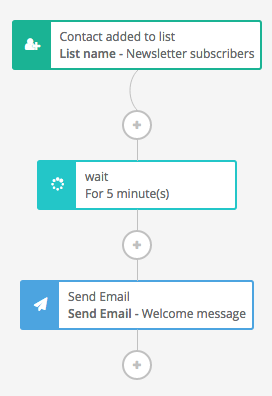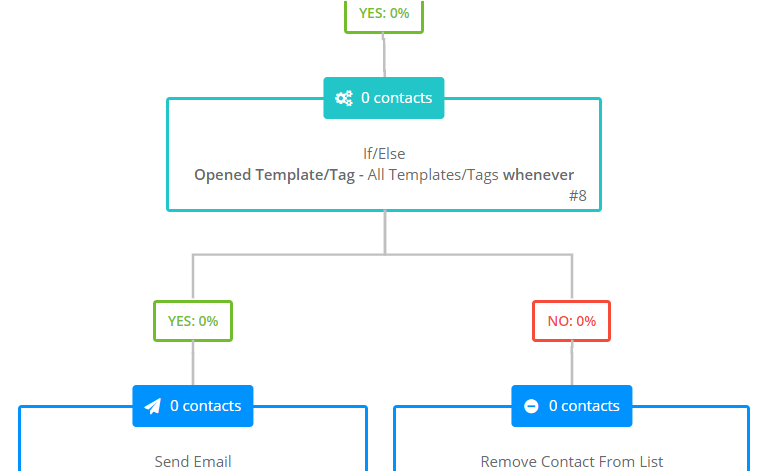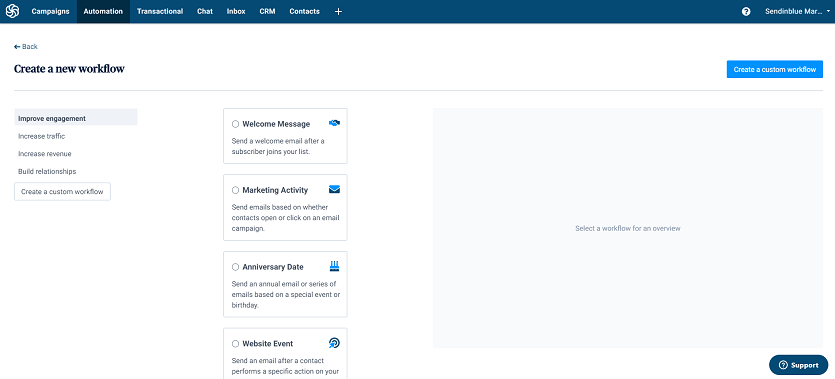

Want to deliver an awesome customer experience and boost your bottom line while you’re at? Email automation is the way forward. Read on to learn how marketers can use this powerful tool to drive business growth.
Effective email communication comes down to two things: timing and relevance.
The right message sent at the right moment is one of the best ways to engage leads.
Of course, it’s easier said than done. How will you know when a person is ready (and actually wants) to hear from you? And where will you find the time to send all those personalized messages?
The answer: email automation. Stay tuned to learn all about this powerful tool and how you can use it to grow your business.
Table of Contents
What is email automation?
Email automation is the process of sending an automated email or email series in response to a pre-defined trigger condition. The trigger can be related to customer behavior, preferences, or other personal/demographic information. Think of it as marketing automation but applied to emails.
How does it work?
Email automation works through the use of automated workflows. These workflows correspond to user information or actions (i.e. clicking a link, visiting a webpage, signing up to a newsletter, etc.).



For a better idea of how this works, check out these marketing automation workflow examples.
Email automation is one of the fastest growing trends in email marketing. Basically, with email marketing automation software, you use whatever intel you have to move leads along the funnel with email messages. This makes it a highly effective email strategy for lead nurturing (more on that later).
Examples of automated email marketing
- Sending a birthday email with a special offer or discount (one of the best emails for conversion!)
- Triggering a welcome email when new subscribers join your email list
- Sending an onboarding email series to new customers (an important part of your CRM strategy)
- Automated drip campaigns
- Sending targeted offers based on landing pages visited (great for ecommerce)
Brands today are moving away from mass email and towards hyper-personalization. And email automation is the most effective way to scale personalized one-to-one communications.
Create an email automation workflow with Sendinblue >>
Email marketing vs marketing automation: What’s the difference?
Email marketing is generally defined as the sending of an email campaign to a list of subscribers (i.e. one message to many people). Email marketing campaigns are great for announcements, promoting a sale, or a time-limited promotion.
On the other hand, email automation or email automation is about one-to-one emails. You send them to follow up on interactions with your email subscribers. These messages serve a specific purpose in the customer journey and your CRM strategy.
Let’s take a look at some of the other key differences between email marketing and email automation:
Manual work
There’s a lot of manual work involved in sending email blasts. With marketing automation, it’s a lot less tedious. Just set up multi-stage automated email series to nurture your leads while you get other work done.
Tracking
Email marketing tracks how subscribers interact with individual email campaigns. It looks at open and click-through rates. But email automation tracks how a subscriber interacts with your business.
To set up email automation you need to have a full picture of the customer journey. Then you create targeted campaigns based on customer behavior.
Audience information
Email marketing tools work with the subscriber information you give them. But marketing automation helps generate even more information through lead scoring.
This is a process whereby leads are ‘scored’ according to how much interest they show. The score acts as an indication of how ‘warm’ or ‘cold’ the lead is and you can tailor your email campaigns accordingly.
Revenue attribution
You need to be able to show how marketing contributes to your company’s bottom line. With email marketing, it’s easy to see if a lead has clicked on a CTA (i.e. call to action). Then you go to your CRM and check if that lead has become a customer.
But how can we be sure the revenue came from that email? The lead may have engaged with a dozen more touch points before converting. But here’s where marketing automation comes in handy. You can easily map consumer behavior and the exact path to sale.
What are the benefits of email automation?
If you want to grow your business fast, basic email marketing won’t be enough.
The more your email list grows, the more email marketing campaigns you need to send. And the harder it’ll be to get the results you need from these mass email blasts.
But email automation is fully scalable. You’ll cover a lot more ground, faster. Use it to put your marketing at full-throttle with drip campaigns and lead nurturing programs.
Let’s look at the main benefits of email automation.
Improve subscriber relationships
The best time to reach out to a customer right is after they’ve engaged with your brand, when you’re still fresh in their minds. This is when they’ll be most receptive to your email messages. So expect higher open rates.
Personalized email messages are key to customer loyalty and the lifeline of every successful business. Email automation lets marketers and small business owners manage these personalized interactions more efficiently.
After all, you don’t want to just convert leads to customers. You want to build brand advocates, right?
Explore this concept further in our guide to building relationships with email.
Better conversion rate
Timing is everything. Automated emails so they deliver on time on time, every time. And without you having to be physically there to hit ‘send’.
Again, it all comes down to sending that email (or email series) when a subscriber’s interest in your brand is at its peak. This’ll lead to higher click-through and conversion rates.
Once you get the hang of automation, you’ll be able to perfect your targeting process. This’ll boost your revenue even further.
Better user experience
A report by PwC states that 1 in 3 customers will leave a brand they love after one bad experience. Just one. That’s all it takes.
Email automation cuts out tedious and repetitive tasks so you can spend more time building a better customer experience.
And here’s another thing: Email automation minimizes the risk of human error. The last thing you want to do is send a message to the wrong email address or email list. Once everything’s set up correctly, this isn’t something you need to worry about.
5 easy ways to use automated emails
Trigger emails should play a key role in your digital marketing strategy.
The welcome email
Welcome emails lay the foundation for your customer relationships. You can introduce yourself, all while learning your customers’ needs and preferences.
Capitalize on this opportunity to make a great first impression and forge a connection.
To be effective, your welcome message should:
- Welcome new subscribers to your community and give them a taste of your brand personality
- Make them want to learn more about your business or content
- Re-state your value proposition
- Guide the reader on the next steps they should take
- Surprise subscribers with a bonus. This could either be a coupon if you have a store or a bonus piece of content they can download immediately.
- Let them know where to follow you on social media
Need some welcome email design inspiration? Try one of these free email templates.
The abandoned cart email
Research shows that almost 70% of ecommerce shoppers leave the site after adding items to their shopping cart.
Adding items to the cart is a strong sign of purchase intent. A sign you shouldn’t ignore.
Smart ecommerce businesses won’t miss the opportunity to use email automation in this situation. They’ll send an automated email encouraging subscribers back to complete the purchase.
Here’s how to make your abandoned cart emails a success:
- Remind people what they’ve left in their cart
- Address any concerns that might have prevented the purchase (delivery time, return policy, customer reviews of the products, etc.)
- Offer a discount
- Notify them if the product is low on inventory or if there is a sale that is about to expire
The birthday email
Birthday emails are one of the easiest, most effective automation workflows you can set up.
All you need is subscribers’ date of birth. Then you can set up a simple workflow to automatically send a birthday email.
According to Experian, birthday emails generate a 481% higher transaction rate than promotional emails.
It’s a great opportunity to grow customer loyalty and positive brand sentiment. Plus, this type of initiative requires very little investment (perfect if you’re a small business).
And think about it: People are more likely to treat themselves to an unplanned purchase on their birthday. An automated email can capitalize on that heightened buying temperature!
Here are our top tips to make your birthday email stand out:
- Keep your email light, friendly, and fun
- Offer a personalized gift coupon based on your customers’ interests
- Craft an intriguing email subject line to boost open rates
- Make sure your email design pops. Your customer is probably getting a lot of email messages on their special day, you want yours to stand out.
The product category follow-up
To send hyper-targeted emails, you’ve got to know your subscribers’ interests. Automated emailing makes this simple with basic tracking.
This product follow-up email is perfect for ecommerce. A subscriber visits a specific product category or page, like shoes. Then you follow-up with targeted email promoting shoes.
So why does this email work so well? Because you catch your potential customer while purchase intent is high, i.e. right after browsing specific products on your site.
Here are our top tips to convert customers with a product follow-up:
- Customize your follow-up message product recommendations
- Include a promo-code to encourage repeat visits
- Include helpful information that addresses common questions about your products or services
- Add a survey to learn more about your customer’s interests and buying habits.
- Ask for a review of a recent purchase
Lead-nurturing emails
One of the biggest challenges for marketers is knowing where a lead is in the buying process.
Email automation is great for lead nurturing.
Lead nurturing is when you send a series of targeted messages based on lead activity and interest shown in your brand. It helps move leads along the funnel towards purchase.
Typically, these emails include different types of content such as resources, product information, offers, and discounts.
Here are our top tips to nurture your most important customers:
- Personalize your email content and subject line to establish a human connection. Address your customers’ pain-points, needs, and ambitions.
- Segment your email lists. Use techniques like dynamic segmentation to ensure your messages are hyper-relevant.
- Map your content and resources to the different steps of the buyer funnel
- Use clear CTAs – what are you trying to get the lead to do at each stage? Sign up for a webinar, download an ebook?
How to set up automated marketing emails
The first thing you need is email marketing software or marketing platform with automation tools.
Sendinblue’s marketing automation software is available for up to 2000 users on the free plan. Sign up is quick and easy, no credit card required.
The first step when it comes to trigger emails is to set up a marketing automation workflow. A workflow is the set of rules that’ll trigger a specific action (in this case, an automated email campaign).
To set up a workflow, you need to decide on the entry point. This is the starting point that sets the workflow in motion.
Examples of entry points:
- Subscriber clicks on call-to-action in email
- Subscriber abandons cart
- New subscriber signs up to your newsletter



Once the subscriber enters the workflow through the entry point, they’ll navigate the rest of the conditions in the workflow as you’ve defined them. The workflow simply uses “if this, then that” logic.
For example:
IF a subscriber abandons the cart before purchase, THEN send email to remind them of what they left behind.


With Sendinblue, entry point conditions fall into two main categories:
- Identity: Based on personal/demographic information stored in your subscriber database. For example, you use a subscriber’s date of birth as a condition to send a birthday email on that date.
- Behavior: How subscribers interact with your website/emails. For example, sending a welcome email to anyone subscribing to your newsletter.
Use these conditions to set up workflows that automatically trigger emails and tasks. Some examples are:
- Send an automated email
- Segment a subscriber by adding to a new email list
- Add or subtract points from subscribers lead score.
Use any combination of conditions to create simple or complex workflows that automate your marketing tasks.
To get you started, Sendinblue has predefined workflows and default templates at the ready so you can start sending automated emails right away.


Key steps to ramp up your email automation
Install the Sendinblue tracking script
Installing the Sendinblue Tracker script allows you to track the pages visited by subscribers via a cookie. Once identified, contacts will automatically be entered into your marketing automation workflows.
The Sendinblue Tracker lets you track key activity on your website. This way you gain valuable insights into user behavior and can target your subscribers according to:
- Webpage visits: Tailor email content according to their needs and interests
- Link clicks: Segment and target subscribers based on link clicks in an email or on a landing page
- Logins and subscriptions: Filter subscribers who have logged into your website or submitted an email signup form.
Follow these simple instructions to set up your tracking script.
NOTE: The automation script only tracks identified users, i.e. users who’ve filled in their email address on your website or users who’ve clicked on your subscription form or in one of your Sendinblue emails.
Set up ‘Custom events‘
For more advanced tracking of user behavior and a better customer experience, try custom events.
Custom events are the most effective way to send hyper-personalized, tailored emails.
For example, if you run an ecommerce site, custom events are great for personalizing abandoned cart emails.
With custom events, you can access all the details of the products in your potential buyer’s cart and display them in your abandoned cart email.
Integrate your CMS
The next step is to plug in your CMS. The Sendinblue Tracker can be activated in just two clicks with several of our plugins, including WordPress, Prestashop, and Shopify.
Here are just some of the benefits of integrating your automated emailing strategy with your CMS:
- Create sign-up forms to embed on your posts or pages
- Manage your Sendinblue subscribers within your CMS
- Trigger automated emails thanks to advanced tracking
- Automatically send an email whenever you’ve added a new post or product to your site
- Design email marketing campaigns from your CMS dashboard
- Access and analyze your campaign statistics to continually optimise performance and results.
Defining the goal/exit condition of a workflow
It’s important to define the exit and restart conditions for your email automation workflow.
These are the rules that define who should and shouldn’t enter your workflow.
“If the subscriber [meets condition X] then remove them from the workflow (exit condition) or bring them back to the beginning of the workflow (restart condition).’
Think of the exit condition as the goal you want your workflow to accomplish.
Let’s look at an example. You’ve entered your subscriber into a stream of nurture emails with the goal of getting them to register for a webinar. And they register. Great.
Now if they’ve already registered, then it doesn’t make sense to continue sending emails. You need to set an exit condition that removes them from the automation workflow.
This avoids frustrating user experiences that could potentially lose you customers.
Similarly, restart conditions tell you when a subscriber has done something that signals the need to start from the beginning. Let’s say your subscriber registers for the event but doesn’t show up. Then it’s time to enter them back into your nurture stream.
Global exit and restart conditions are important to show you recognize and value new customers. They also prevent customer churn and provide an overall seamless customer experience.
Start driving results with email automation
Automation is becoming more and more linked to email marketing success.
Not only does automation help build better customer relationships, it also frees up a ton of time and energy. This means you can work strategically and spend your time where it matters most.
If you want to scale one-to-one personalized communication and transform leads into loyal customers, then email automation is the fastest way forward.
In the meantime, follow us on social media for a daily dose of marketing tips!
 Deutsch
Deutsch





















Comments
Brilliant guide! It is always difficult to automate and customize the emails sometimes. Especially this one is a huge productivity waste. Keep up the good work.